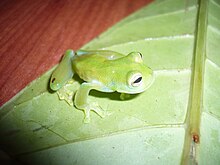
The glass frogs are frogs of the amphibian family Centrolenidae. While the general background coloration of most glass frogs is primarily lime green, the abdominal skin of some members of this family is transparent and translucent. The internal viscera, including the heart, liver, and gastrointestinal tract, are visible through the skin, hence the common name is given as glass frog. Glass frogs are arboreal, meaning they mainly live in trees, and only come out for mating season.

Cochranella is a genus of glass frogs, family Centrolenidae. They are found in Central America from Honduras southward to the Amazonian and Andean cloud forests of Colombia, Ecuador, Peru, and Bolivia.

Chimerella mariaelenae is a species of glassfrog that inhabits on the Andean slopes of eastern Ecuador and northeastern Peru. The species was described as new to science by Diego F. Cisneros-Heredia and Roy W. McDiarmid in the journal Zootaxa.

Sachatamia ilex is a species of frog in the family Centrolenidae. It is found in eastern Nicaragua, Costa Rica, Panama, western Colombia, and western Ecuador. Common name Limon giant glass frog has been coined for this species, apparently in reference to its type locality in the canton of Limón, Costa Rica, and it is also known as the ghost glass frog.
"Centrolene" medemi is a species of frog in the family Centrolenidae. The species occurs in the Cordillera Oriental in the Tolima, Caquetá, and Putumayo Departments in Colombia and adjacent Napo in Ecuador. The generic placement of this species within the subfamily Centroleninae is uncertain. The specific name medemi honors Fred Medem, collector of the holotype. Common name Medem giant glass frog has been coined for it.
Teratohyla adenocheira is a species of frogs in the family Centrolenidae. It is known from the Noel Kempff Mercado National Park, its type locality in eastern Bolivia, as well as more widely from Brazil, in the states of Mato Grosso, Pará, and Rondônia.
Nymphargus bejaranoi is a species of frog in the family Centrolenidae. It is endemic to the eastern slopes of the Bolivian Andes in the Cochabamba, Chuquisaca, La Paz, and Santa Cruz departments. The specific name bejaranoi honors Gastón Bejarano, a Bolivian zoologist and Director of Forestry and National Parks, Ministry of Agriculture. Common name Bolivian Cochran frog has been coined for this species.
Vitreorana castroviejoi is a species of frog in the family Centrolenidae. It is endemic to Cerro el Humo in the Paria Peninsula, Sucre state, northern Venezuela. It is locally known as ranita de cristal de Castroviejo. The specific name castroviejoi honors Javier Castroviejo Bolívar, a Spanish zoologist.
"Cochranella" duidaeana, commonly known as the Duida Cochran frog, is a species of frog in the family Centrolenidae. It is endemic to Cerro Duida, Venezuela. The generic placement of this species within the subfamily Centroleninae is uncertain.

"Cochranella" euhystrix is a species of frog in the family Centrolenidae. It has an uncertain placement within subfamily Centroleninae. It is endemic to Peru and only known from the vicinity of its type locality near Cerro Blanco, in the Zaña River watershed, Department of Cajamarca. The specific name euhystrix refers to the unusually spiny appearance of this frog, especially males. Common name ridge Cochran frog has been proposed for this frog.

Cochranella euknemos, sometimes known as the San Jose Cochran frog, is a species of frog in the family Centrolenidae. It is found in central Costa Rica and south/eastward to Panama and to the western flank of the Cordillera Occidental in Colombia. Some Colombian records might apply to Cochranella mache.
Nymphargus pluvialis is a species of frog in the family Centrolenidae. It is known from the area of its type locality, Pistipata, Río Umasbamba, in the Huayopata District of the Cusco Region of Peru as well as La Paz, Bolivia. Its common name is Pistipata cochran frog, although it no longer is included in the genus Cochranella.

Cochranella resplendens is a species of frog in the family Centrolenidae. It is found in the upper Amazon Basin in southern Colombia, eastern Ecuador, and San Martín Region of northern Peru. It is sometimes known as the resplendent Cochran frog.

Vitreorana ritae is a species of frog in the glass frog family (Centrolenidae). It is found in Amazonian Brazil, Colombia, Ecuador, and Peru, and in southern Guyana, eastern Suriname, and French Guiana. Its natural habitats are tropical moist lowland forests and rivers. It is threatened by habitat loss.
Nymphargus siren is a species of frog in the family Centrolenidae, formerly placed in Cochranella. It is found in Colombia, Ecuador, and Peru. Its natural habitats are pre-montane forests near streams. It is threatened by habitat loss.
Rulyrana spiculata is a species of frog in the family Centrolenidae. It is endemic to the eastern slopes of Andes in central and southern Peru and northern Bolivia. Common name Cuzco Cochran frog has been coined for it.

Hyalinobatrachium pellucidum, also known as the Rio Azuela glass frog, is a species of frog in the family Centrolenidae. It is found in lower montane rainforests on the Amazonian Andean slopes in Ecuador and Peru. The specific name pellucidum is Latin for "transparent" and refers to the transparent parietal peritoneum of this species.

The powdered glass frog or Chiriqui glass frog, Teratohyla pulverata, is a frog species in the glass frog family (Centrolenidae). The species is found from north-central Honduras south to northwestern Ecuador.

Ameerega trivittata, formerly Epipedobates trivittatus, is a species of frog in the family Dendrobatidae commonly known as the three-striped poison frog. It is found in Bolivia, Brazil, Colombia, Guyana, Peru, Suriname, Venezuela, possibly Ecuador, and possibly French Guiana.

Centrolene savagei is a species of frog in the family Centrolenidae that is endemic to the Andes of western Colombia, specifically the Cordillera Occidental and Cordillera Central. Its common name is Savage's Cochran frog.













